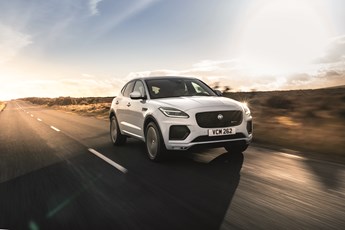
The start point for the best source of fleet information |
First drive: Jaguar E-Pace plug-in hybrid
Date: 24 March 2021 | Author: Simon Harris

|
|
||||||||||||||||
The Jaguar E-Pace has probably been less of a success for the company than it hoped. Launched into a crowded sector three years ago, its high-ish CO2 emissions from its otherwise clean diesel engines hampered its chances among user choosers.
But as Jaguar outlines its electric car future, it has launched a plug-in hybrid version of the E-Pace that instantly makes it a more desirable car for the corporate sector.
It coincides with an extensive facelift for the entire E-Pace range (it doesn't look so different on the surface, but a new platform was necessary to accommodate the hybrid hardware), with exterior changes and interior upgrades. It now looks better value too, with extra equipment and more power.
The plug-in hybrid, driven here in left-hand drive configuration, is the most powerful E-Pace currently available, although the powertrain, combining a three-cylinder 1.5-litre turbocharged petrol engine with a powerful electric motor, is one we've already seen in the Range rover Evoque and Land Rover Discovery Sport.
As an aside, Jaguar Land Rover knows the powertrain is capable of up to 40 miles of range in some derivatives of the Evoque, Discovery Sport and most likely the E-Pace, but the pandemic has caused a backlog in getting the cars retested.
Having 40 miles certified would reduce the BIK tax burden by four percentage points from its current level, although as things stand, the E-Pace is still competitive, and its 34 miles of EV range is better than some of its rivals.
Jaguar's natural rivals are adrift of the E-Pace on power - BMW and Mercedes-Benz plug-in hybrids in this class can muster no more than 220hp against the Jaguar's 309hp, while Volvo's XC50 Recharge T5 produces 262hp.
So, it shouldn't be much of a surprise that the Jaguar looks a little more expensive than premium-badge alternatives.
Perhaps more surprising is the R-Dynamic S - the entry-level grade for plug-in hybrid variants - is just about the same price as the Peugeot 3008 Hybrid4 GT, which is comparable for power.
As well as performance, the Jaguar has a much more cultured interior than its rivals. It has a
new 11.4in Pivi Pro multimedia touchscreen, which is concave and helps reduce reflections. It powers up before the car is started and eliminates any lag you might get with other touchscreens, especially in navigation mode.
There is an impressive list of standard equipment, although upgrading to SE or HSE adds even more. The E-Pace is also available with a new head-up display, which seems to cram in more info than many similar systems, as well as satnav graphics when appropriate.
Performance is sports-car-like when engine and electric motor chime in together, and the 0-62mph of 6.1 seconds feels effortless.
Under normal driving conditions, progress is serene and refined, and even under hard acceleration, there's none of the off-beat trill sometimes produced by three-cylinder engines.
The E-Pace feels rather more agile on the road than a typical medium SUV too, although it's perhaps helped by the low-mounted battery contributing to a more neutral gait when being hustled along a country lane. When the E-Pace launched, Jaguar wanted to draw analogies with the F-Type, and it still feels the most nimble model behind the sports coupé.
It is quite a compact car, shorter than most of its rivals and, perhaps, rear seat space is compromised as a result. The plug-in hybrid kit also reduces the amount of luggage space available, which, at 415 litres with the rear seats in place, is not a disaster, but a little shy of some of its rivals.
So can the premium be justified? Well it rather depends on the employee and why they're choosing a plug-in hybrid. If they're doing it to minimise BIK tax and want an SUV for the practicality, pushing the boat out for the Jaguar might be too much to ask.
But it certainly has much more going for it than in its original guise, whether choosing petrol, diesel or plug-in hybrid.
Jaguar E-Pace P300E R-Dynamic S
P11D: £45,940
Residual value: 45%
Depreciation: £25,276
Fuel: £2,251
Service, maintenance and repair: £2,898
Cost per mile: 50.7p
Fuel consumption: 143.1mpg
CO2 (BIK %): 44g/km (11%)
BIK 20/40% a month: £84/£168
Boot space: 425 litres
Engine size/power: 1,498cc/309hp
Verdict |
8/10 |
|||
 |
|
 |
|
|










